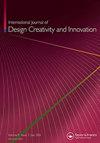模糊视觉刺激对设计创意产生的影响
IF 2.5
Q4 ENGINEERING, MANUFACTURING
International Journal of Design Creativity and Innovation
Pub Date : 2018-05-29
DOI:10.1080/21650349.2018.1473809
引用次数: 6
摘要
摘要本研究旨在探讨视觉刺激对设计师创造力的影响。本研究对设计专业学生进行了一项调查,从亚符号域(模糊刺激)、符号域(确定刺激)和两个域之间的视觉刺激(歧义刺激)中提取视觉刺激。随后,使用选定的刺激进行了概念组合实验,以检验模糊视觉刺激对设计师创造力产生想法的影响。结果表明,在个体工作环境中,当存在模糊刺激时,不同的概念对促进了更高的阐述,而当存在模糊激励时,相似的概念对则促进了更大的阐述。研究进一步表明,在小组工作环境中,当使用不同的概念对时,模糊刺激会导致更高的抽象性,而当使用相似的概念对,模糊刺激则会导致更大的抽象性。本文章由计算机程序翻译,如有差异,请以英文原文为准。
The effect of ambiguous visual stimuli on creativity in design idea generation
ABSTRACT The purpose of the present study is to investigate the effect of visual stimuli on creativity for generating ideas among designers. A survey with design students was conducted in this investigation to extract visual stimuli from the sub-symbolic domain (vague stimuli), visual stimuli from the symbolic domain (definite stimuli), and visual stimuli between the two domains (ambiguous stimuli). Subsequently, a conceptual combination experiment was conducted using selected stimuli to examine the effects of ambiguous visual stimuli on creativity to generate ideas among designers. The results suggest that in individual working environments, dissimilar concept pairs fostered higher elaboration when ambiguous stimuli were present, whereas similar concept pairs fostered higher elaboration when vague stimuli were presented. It was further suggested that in group working environments, vague stimuli result in higher abstractness when dissimilar concept pairs are used, whereas ambiguous stimuli result in higher abstractness when similar concept pairs were used.
求助全文
通过发布文献求助,成功后即可免费获取论文全文。
去求助
来源期刊

International Journal of Design Creativity and Innovation
ENGINEERING, MANUFACTURING-
CiteScore
3.80
自引率
27.80%
发文量
15
期刊介绍:
The International Journal of Design Creativity and Innovation is an international publication that provides a forum for discussing the nature and potential of creativity and innovation in design from both theoretical and practical perspectives. Design creativity and innovation is truly an interdisciplinary academic research field that will interest and stimulate researchers of engineering design, industrial design, architecture, art, and similar areas. The journal aims to not only promote existing research disciplines but also pioneer a new one that lies in the intermediate area between the domains of systems engineering, information technology, computer science, social science, artificial intelligence, cognitive science, psychology, philosophy, linguistics, and related fields. The journal covers, but is not restricted to, the following topics: ·Theories on Design Creativity and Innovation ·Cognition of Design Creativity ·Innovative Process ·Inventive Process ·Analogical Reasoning for Design Creativity and Innovation ·Design Synthesis ·Method and Tools for Design Creativity and Innovation ·Representation of Design Creativity and Innovation ·Education for Design Creativity and Innovation ·Concept Generation and Inspiration.
 求助内容:
求助内容: 应助结果提醒方式:
应助结果提醒方式:


